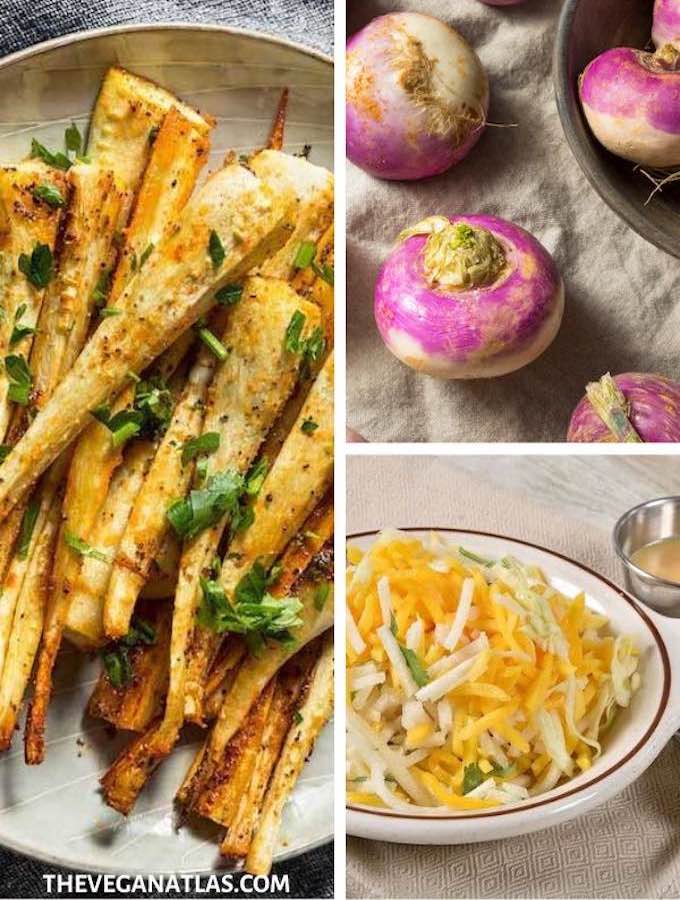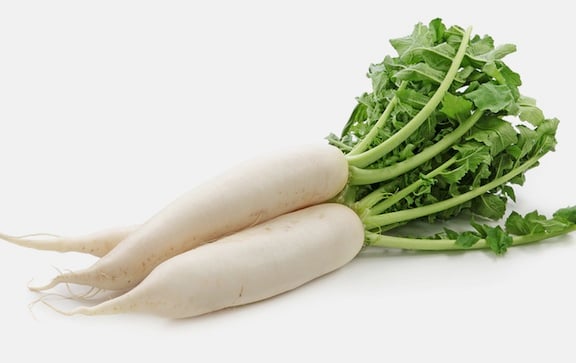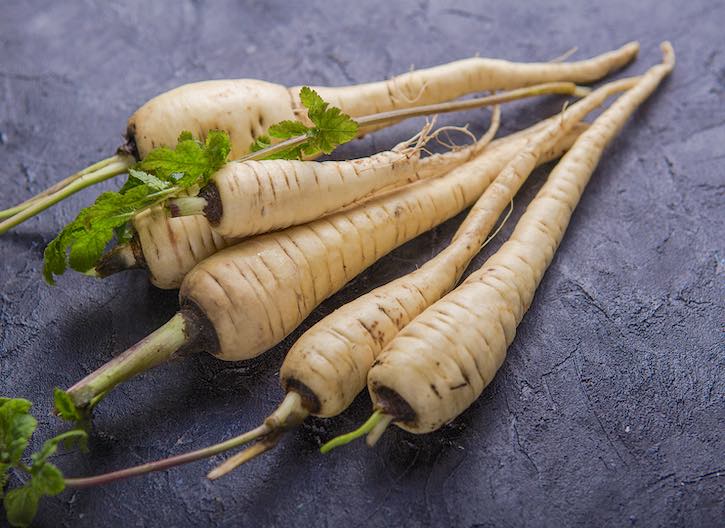Root vegetables are a hardy produce group that’s perfect for cool season meals. Roots have long been more traditional to fall and winter recipes. Here’s a concise root vegetables list of five common varieties that deserve a spot in your cool-season meals, with links to recipes.

Roots like carrots are an already familiar enough to most cooks, so here we’ll focus on a few others that are just as tasty and versatile, relatively easy to find, and well worth adding to your rotation.
Root vegetables may not be the nutrient standouts as the green and orange vegetables, but they’re still good choices to add to your fall and winter repertoire — high in fiber, antioxidants, vitamins, and minerals.
The root vegetables highlighted in this post are:
- Daikon radish
- Jerusalem artichokes (sunchokes)
- Jícama
- Parsnips
- Turnips
Warmer weather roots
In the warmer months, be sure to add kohlrabi and any of the myriad radish varieties to your roots repertoire (including watermelon radish). Beets have become a year-round root, just as welcome in cool weather and warm weather meals.
 Most roots, like parsnips shown here, are fantastic to roast!
Most roots, like parsnips shown here, are fantastic to roast!
Basic ways to use root vegetables
Raw or cooked? All the root vegetables listed below can be used cooked or roasted. Daikon radish, jícama, sunchokes, and turnips can be used raw as well‚ in salads or cut into rounds or sticks and used as part of a vegetable platter.
Roasted: Root vegetables take on a seductive sweetness when roasted. Combine any of those listed here with one another. You can combine them with carrots, beets, potatoes, sweet potatoes, or yams. Try this flexible recipes for Classic Roasted Root Vegetables with Lots of Variations.
Sautéed or stir-fried: Roots are a great addition to sautés and stir-fries. A quick spin in the pan preserves their crispness.
Pickled: The roots that are good raw are great pickles, too. Daikon, jícama, sunchokes, and turnips can be preserved and canned; even easier is to turn them into quick refrigerator pickles. Use the same formula given for Watermelon Radish Pickles to make the quick variety.

Daikon radish
The word daikon comes from two Japanese words, dai (large) and kon (root). And that’s literally what it is. This radish variety is commonly about a foot long, and increasingly common in the produce section of well-stocked supermarket.
Slightly sweet and surprisingly juicy, daikon has a bite that’s milder than red radishes. It’s a radish that’s easy to love, and versatile in the kitchen (tip: it’s great pickled!). Learn more about daikon radish.
- Cold Asian Noodle Bowls with Daikon and Carrot
- Daikon and Carrot Salad with Red Cabbage
- Purple Daikon Salad with Golden Beets and Bok Choy
- Winter Vegetable Miso Soup
- Tatsoi Salad with Bok Choy, Daikon, and Oranges

Jerusalem artichokes (aka sunchokes)
The misnamed underground tubers of a native American sunflower have nothing to do with Jerusalem and aren’t related to artichokes. To allay the confusion, they’re now often marketed as sunchokes. Their true season is in late fall.
Their knobby skin can be a bit of a challenge. If it looks clean, you can just scrub it, and cut away larger knobs. Their flavor and texture make the extra work worthwhile. Think of them as a crunchy cross between water chestnuts and potatoes.
They’re best sliced and used in salads or roasted in medleys with other vegetables. Learn more about Jerusalem artichokes, aka sunchokes.

Jícama
This delectable root (pronounced HICK-a-mah) is native to the American Southwest, and until the last decade or so was not easy to find outside that region.
Now it’s easier to find in well-stocked supermarkets and produce stores from west to east, primarily in late fall, though like many forms of produce, its season has been extended.
Sweet, crunchy, and a bit more watery than other roots, jícama is good sliced and used raw in salads, sliced and combined with other vegetables (or fruits) on cold platters, sautéed, roasted, and stir-fried.
One Asian restaurant in my area has replaced the customary water chestnuts with jícama — a brilliant idea, as it’s fresher, crisper, and has more flavor.
See this site’s Guide to Jícama for lots more tips, ideas, and recipes.
- Avocado and Jícama Salad with Blueberries & Roasted Corn
- Jícama and Fennel Salad with Oranges and Herbs
- Stir-Fried Jícama and Snow Peas

Parsnips
Parsnips look a bit like awkward beige carrots, and indeed, they’re related to them, and also to parsley. A good reason to buy them in season, about mid to late fall (depending on where they’re grown), is that the cool weather conditions in which they’re grown converts some of their starches to sugar — making their flavor delightfully sweet.
The most common use for parsnips may be as an addition to winter soups, but don’t forget to try them roasted — either as part of a medley or on their own.
There’s no reason you can’t eat them raw (especially if finely grated) but they’re not as good that way.
Parsnips have a sweetish, distinct flavor that melds well with carrots, potatoes, and sweet potatoes in soups, stews, and roasted dishes. Here’s more than you’ll ever want to know about parsnips.
- Carrot-Ginger Soup (with a Parsnip Variation)
- Miso Roasted Root Veggies
- Roasted Root Vegetable Salad
- Creamy Vegan Parsnip Vegetable Soup
- Hearty Winter Root Vegetable Soup

Common turnips

Baby turnips
Turnips
This humble root comes in many varieties, though the ones most commonly seen in supermarkets are the white variety with the reddish blush.
Nearly as common are turnips that are a creamy white on the outside. Scour late-fall farm markets for more unusual varieties, as well as baby turnips, which are lovely and tender, and often have deliciously usable greens.
Turnips are just as good used raw as lightly cooked or roasted. They’re traditional to the cuisines of the Southern U.S., where their greens are valued as much as the root.
Make sure to choose turnips with smooth skin that feel heavy for their size. At their best, turnips can be slightly sweet with a mild peppery bite.
They can be a bit unreliable — a turnip that looks fine on the outside can potentially be rather dry on the inside. In that case, use in soups and stews. Here’s more info on turnips.
- Spaghetti Squash Stew with Turnips & Snow Peas
- Turnips with Caramelized Onions and Toasted Lentils
- Vegan Turnip Gratin
- Raw Turnip Salad

You’ll find other types of roots (and tubers) in this exploration of Caribbean and Latin American Vegetables.
See more of our Good Food Guides.

Leave a Reply